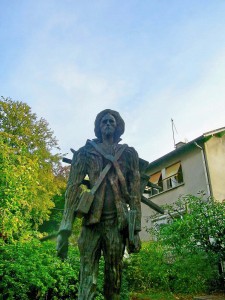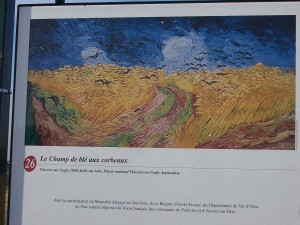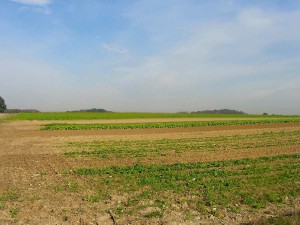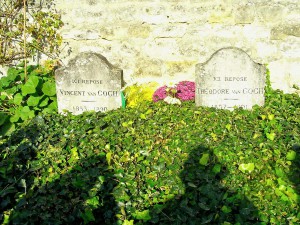FROM PARIS TO NORMANDY ON THE SEINE – FOLLOWING VAN GOGH
FROM PARIS TO NORMANDY ON THE SEINE
This is the fourth in a series of articles about cruising on the Seine
FOLLOWING VINCENT VAN GOGH IN AUVERS SUR OISE
By Charles N. Stevens
Photos by Dolores Seidman
The world has disappeared this morning, the river fog as thick as yogurt, the town of Conflans only a hazy sketch. Outside, I breathe the fog, inhaling its cold wetness deep in my throat. As the sun rises the fog thins, the wooded slope across the river and the gulls that ply the water now visible. The dissipating fog swirls off the water and drifts down the Seine. A coal barge emerges from it as though coming out of nowhere.
A short bus trip takes us to Auvers Sur Oise where Vincent Van Gogh once painted and where he died. We begin in a small park at a bronze statue of the painter, a lively one that almost appears to be in motion. He is slender, almost gaunt with an easel strapped to his back, a cap on his head, his equipment under his arm or bound to him. As he strides forward his intense expression makes him appear serious, almost tortured.
Beginning a walking tour, we pass by the hotel on Rue du Café de la Paix. A short walk from here is La Marie d’Auvers, the Hotel de Ville or city hall that Van Gogh set down on canvas in 1890. It is today just as it was when he painted it and a sign with the painting on it is erected in front of it. The people of the town, recognizing what historical significance their town has, has decided to change nothing, keep the town as it was.
We walk by the Auberge Ravoux where he stayed until he died in 1890. We stroll up a small street or alley where we find another sign on a stone building bearing one of his paintings, this one of a woman, Portrait d’Adeline Ravoux. Not far away is another fixed to a stone wall, L’ Escalier d’Auvers, a depiction of the very same street we stand on, the same stairs and houses ahead, the women he painted walking down this street long gone. The only life in the street today is the shuffle and babble of our group and a gray cat that sits on the steps ahead running his pink tongue through his fur.
A longer walk takes us to the church, L’Eglise d’Auvers, once painted by Van Gogh but now nearly covered in scaffolding, the sounds of hammers and saws echoing in the structure. From the depiction of his painting outside it is clear to us how the church looks. Of course his rendition of it in the impressionist style makes it seem a little crooked and more colorful than it actually is, but that is the privilege of the painter.
Up a steep hill we trudge on to the next sight, most of us panting and stopping to get our breath. At the crest of the hill are agricultural fields, the first one a cut corn field with crows gleaning among the rubble. The scene is appropriate as it is where Van Gogh painted his Wheatfield with Crows, his final painting. His version depicts a wild sky with scattered crows and vivid yellow wheat.
Walking on through fields planted with spinach, broccoli and anise, we reach the cemetery where Vincent Van Gogh and his brother Theo are buried. Their graves are quite plain but many graves around theirs are decorated with glazed ceramic roses and flower wreaths. On his gravestone are the words Ici Repose, Vincent Van Gogh, 1855-1890.
In the afternoon we leave Conflans. It’s pleasant along the river, floating down it, looking out at the trees along the shore and fine houses with lawns sloping to the banks. Blue herons stalk the muddy banks, and a group of Canada geese swim slowly by. Four swans fly by, their great white necks extended forward. White billed coots cruise among the ducks. Weeping willows dip their fronds in the water as though they are drinking.
As well as scenes of nature along the Seine, we pass power plants, warehouses and container ports. Most impressive is the high Notre Dame Church at Mantes-La Joloie, spectacular on its hill. The views change constantly. A flock of gulls, like a whirlwind of white paper, follow a tractor tilling a field. Swans go about their business, just looking like swans should, or dunking their long necks toward the river bottom with their feathery white rear ends protruding in the air.
After a while we come upon snow-white cliffs, similar to the white chalk cliffs of Dover, and apparently the same strata. Caves or openings in the cliffs attest to their softness. Some appear to be doors and windows as though people live in houses dug into the rock. Nestled just below the chalk cliffs is a large chateau once used by Rommel, the German General, during World War II as his headquarters. It is said that he met secretly here with the Allies to talk about ending the war. He also met with Hitler here, warning him that Germany could not win the war. This infuriated Hitler, and soon afterward Rommel was killed in an “automobile accident.” The chateau was recaptured in 1944.
Soon after we pass the impressive La Roche Guyon Chateau high on a hill, we dock at Vernon, our home for another day.

This grim statue of Vincent Van Gogh stands in a Auvers Sur Oise park.

This billboard of Van Gogh's last painting, "Wheatfield with Crows", stands in the very field where he painted it.


The graves of Vincent Van Gogh and his brother Theo-only a short distance from where he composed his last painting.




Oh, it makes me want to go visit there!